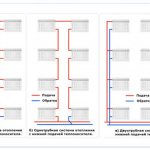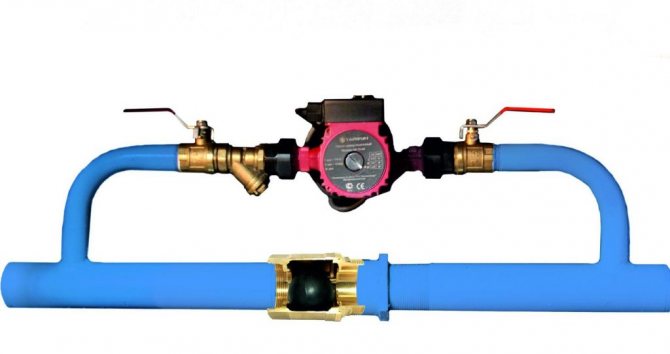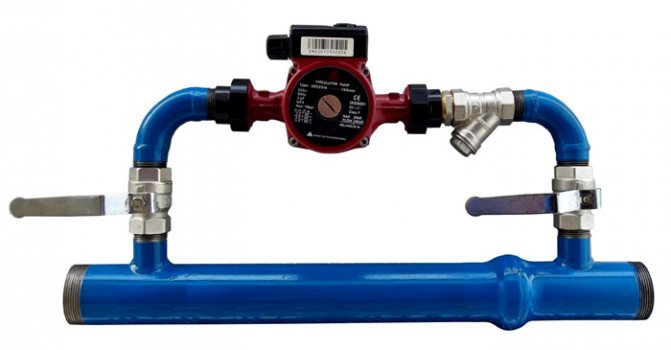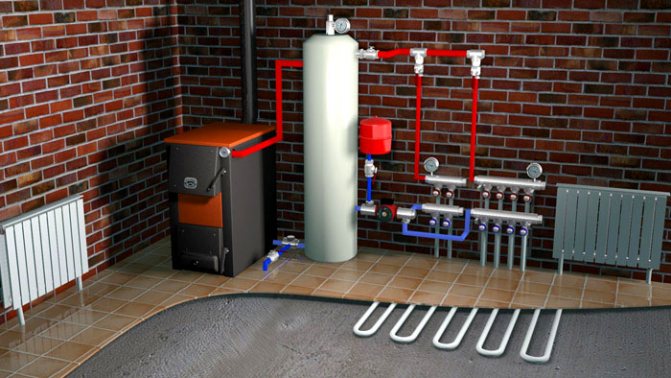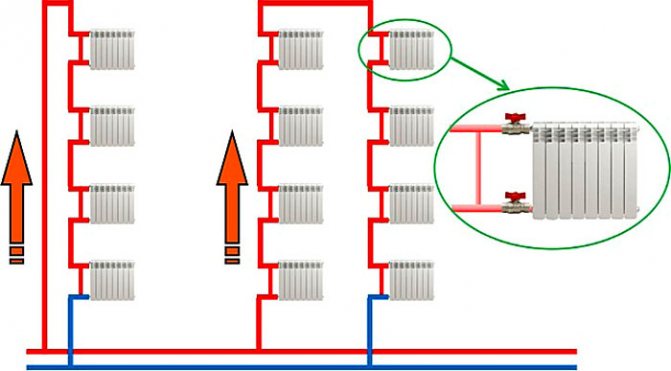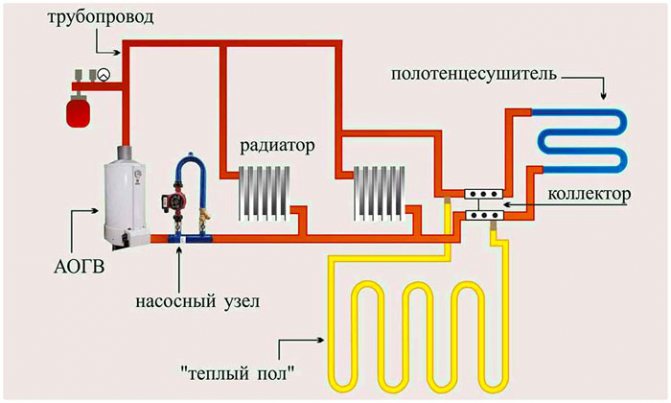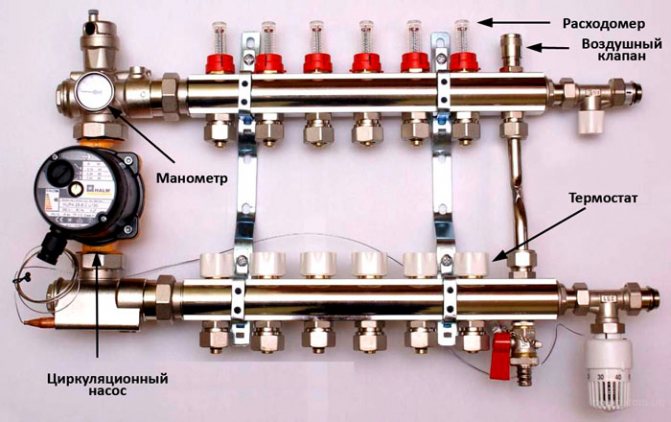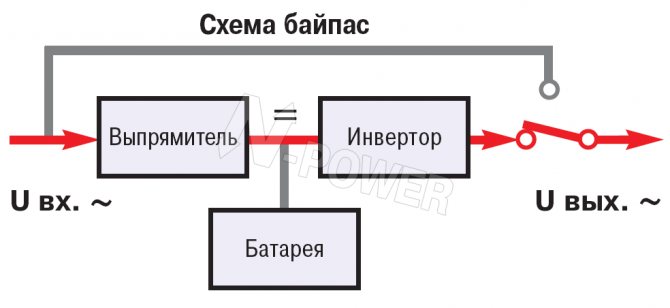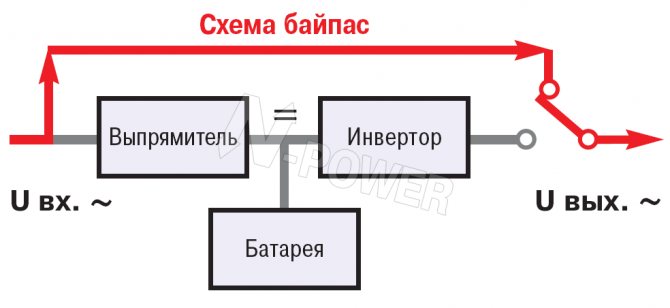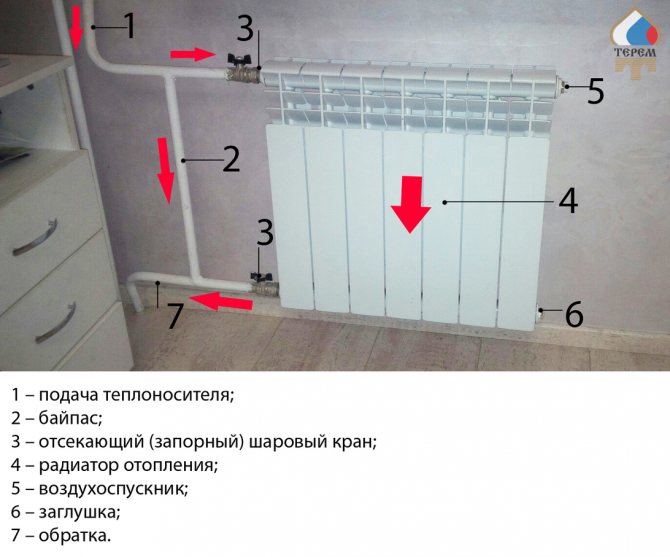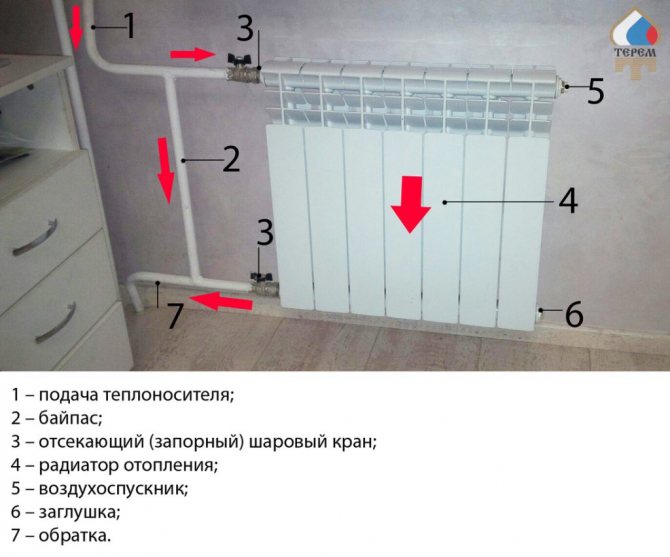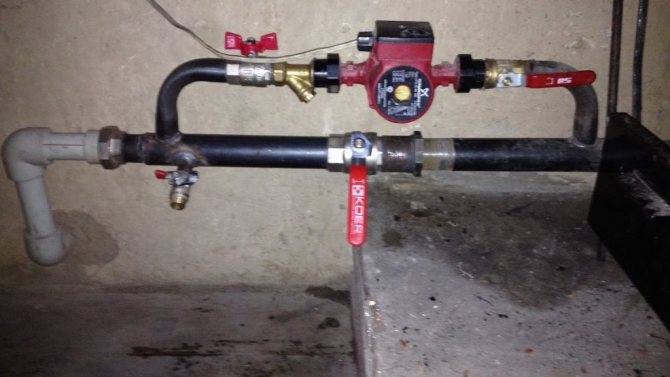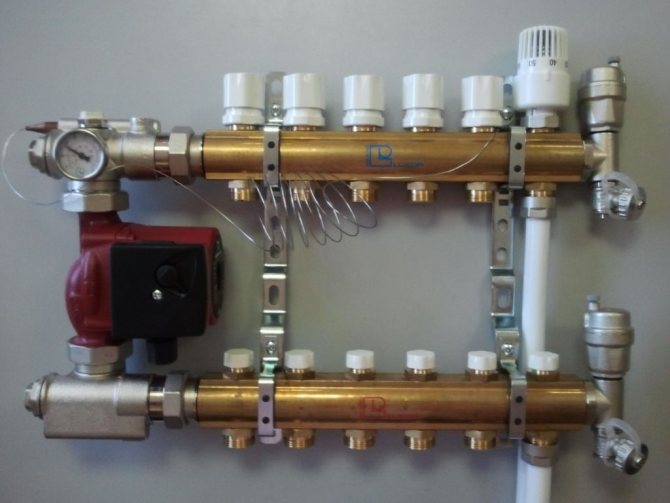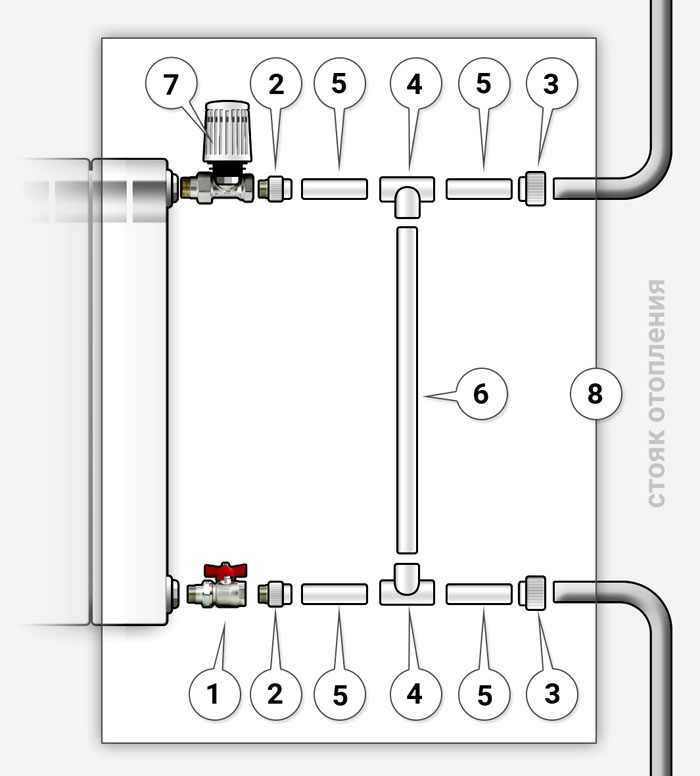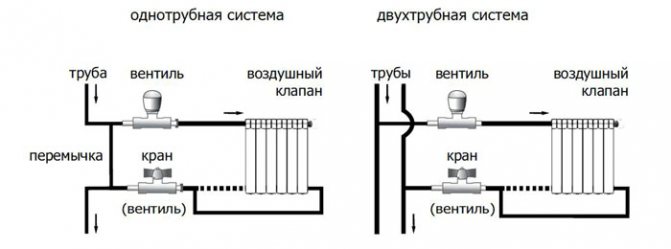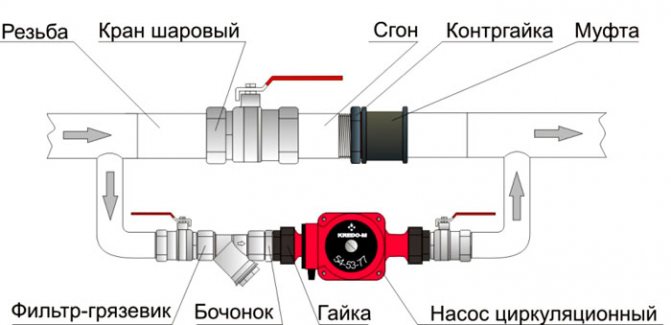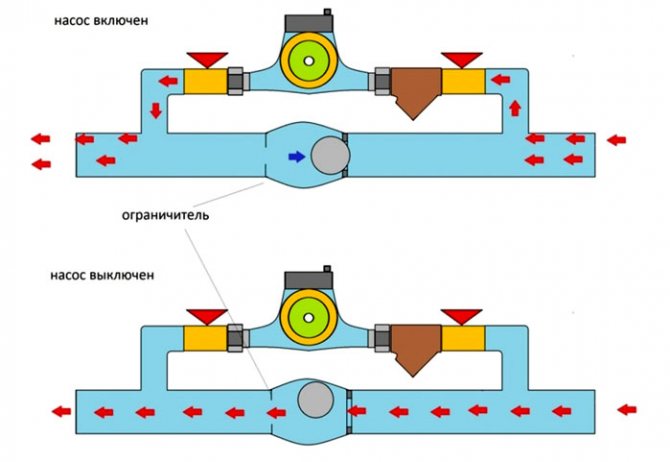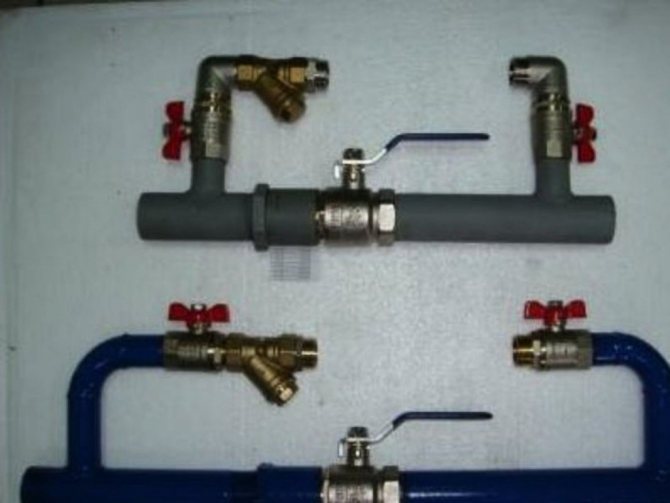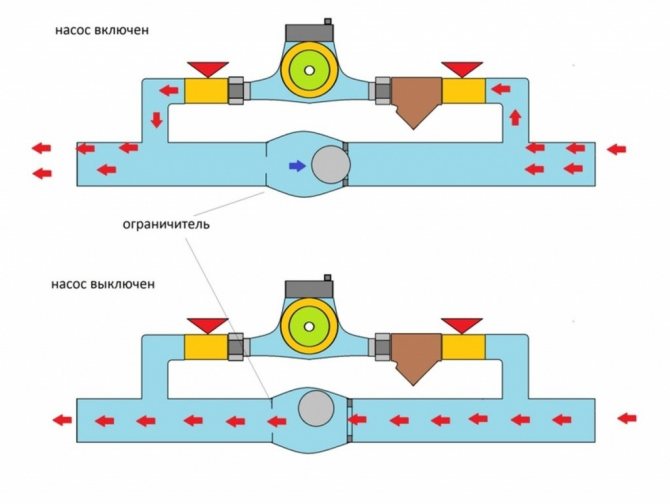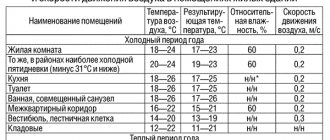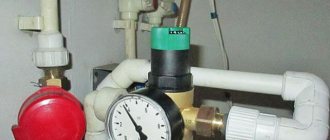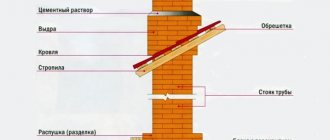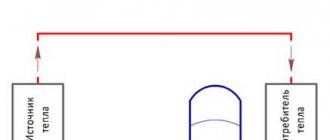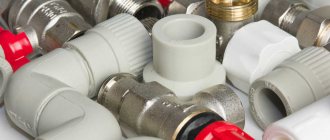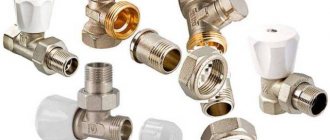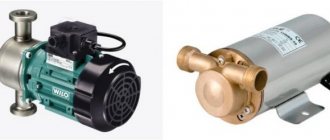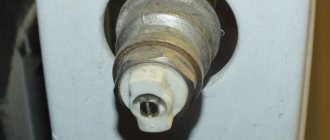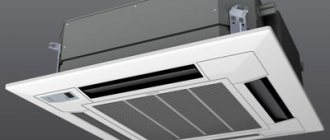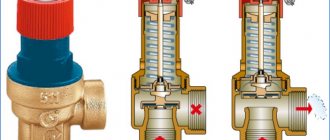When planning heating systems, various wiring methods are used, one of which is a bypass. What is a bypass in a heating system, every specialist in the development and installation of domestic heating systems knows, the information can be useful to the owner of a cottage or summer house if he is engaged in arranging the heating of his home with his own hands.
Although the bypass is the simplest detail, it cannot be dispensed with in multi-apartment high-rise buildings with economical single-pipe wiring, the use of the element is also widely practiced in domestic heating networks. When arranging heating, the correct placement of the bypass in the right places allows you to achieve high efficiency of heating the room, save financial resources, and avoid the negative consequences of emergencies that arise during the operation of the equipment.
Fig. 1 One-pipe and two-pipe connections
What is a bypass in a heating system
Bypass - the Russian-language pronunciation of the English word “bypass”, translated means bypass, bypass, bypass, detour. The device plays a similar role in the pipeline system - it creates a bypass path for the working fluid, becoming a kind of bypass bridge between the entry and exit points of the included heat exchange devices.
Structurally, the part is a short piece of pipe made of a material similar to the pipes, installed at a short distance from the inlet and outlet fittings of the connected heat exchanger. The pipe section can be welded in the case of using metal pipes, fixed to threaded fittings when using metal-plastic, soldered into the polypropylene line.
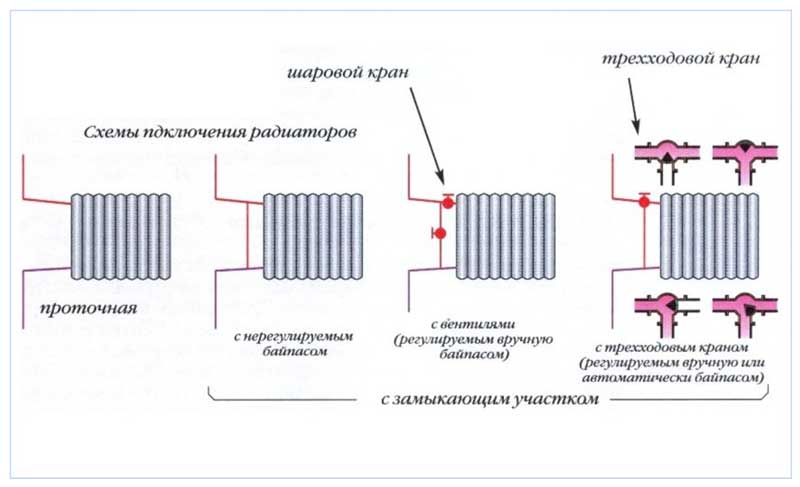
Fig. 2 Radiator connection diagrams
Why do you need a bypass in the heating system
To understand what a bypass is for, and to appreciate the importance of installing this element, you should consider the main types of wiring for household heating systems.
When installing household heating systems, a sequential (one-pipe) and parallel (two-pipe, collector) supply of a working fluid to heat exchange units is distinguished, in the first case, the coolant passes sequentially through all devices, gradually cooling at the end. With a sequential scheme, the coolant is supplied to the heat exchangers from the highest point or from the bottom, while it circulates in a closed ring, returning to the boiler through the return pipes.
A single-pipe system requires less materials for placement and is widely used in multi-apartment housing; during installation, to avoid the main drawback - weak heating of the most distant radiator in the network, inserting a bypass jumper helps. The purpose of the bypass is to create an additional path bypassing all radiators, providing a coolant supply of the same temperature to each of them, this contributes to a more uniform heating.
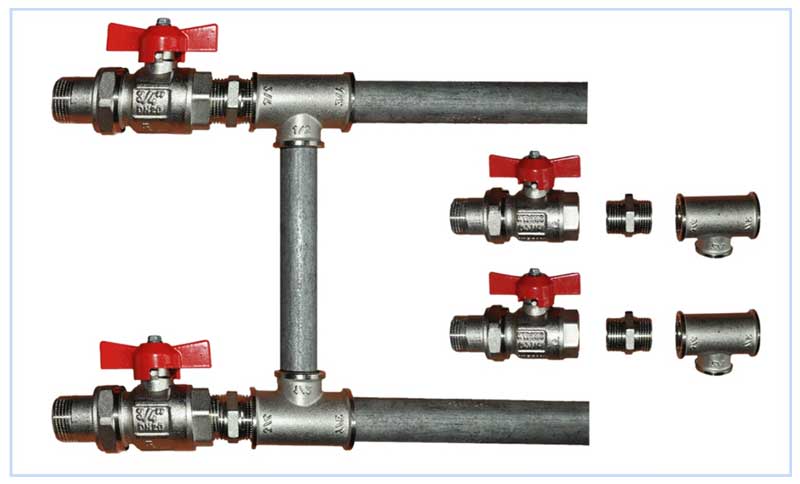

Fig. 3 Structural metal bypass device and its connection
The second important function of the installed bypass branch pipe is to ensure uninterrupted delivery of the coolant to all radiators in the event of a breakdown or disconnection of one of them in the serial circuit. From the diagram in Fig. 1, it is clear that in the absence of a bypass between the pipes, if one of the radiators fails (leakage, blockage), the delivery of the coolant to the subsequent circuits stops, as a result of which the residents are left without heat, and the entire system is threatened by freezing.
The third purpose of the bypass is to maintain a constant circulation of the coolant in the event of a breakdown of the compression pump of the heating system. In the case of a bypass, the system works in a natural way, providing circulation bypassing the pumping line - this guarantees uninterrupted heating of the premises in the dwelling. It should be noted that in order to ensure the mode of natural circulation when the pump is turned off, an appropriate design is necessary (large diameter pipes, slopes); if these conditions are not met, the circular movement of the liquid due to thermal expansion should not work.
An important advantage of the bypass is the ability to turn off any radiator for its repair, preventive maintenance or replacement. This is achieved due to the location of two ball valves on the radiator inlet and outlet fittings, after they are locked, the radiator can be easily removed for repair, maintenance, building up additional sections. The bypass performs similar functions when installed in parallel in the circuit of the compression electric pump - with the help of two ball valves, the electric pump is easily disconnected from the heating network for repair, maintenance, replacement of equipment without draining water and stopping heating of the premises.
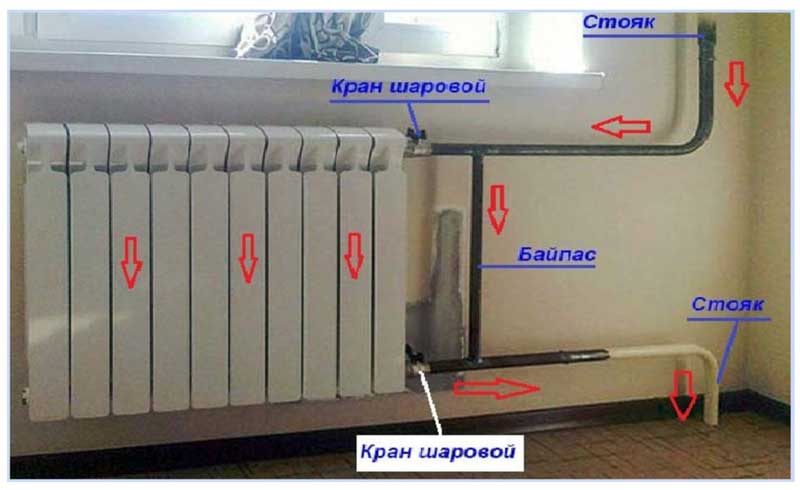

Fig. 4 The principle of operation of the bypass in the heating radiator circuit
What are the types of bypasses
Although the bypass is a fairly simple element, the range of its functions can be significantly expanded through the use of various types of sanitary fittings built into it. The design of the bypass depends on the line in which it is used, the type of residential or industrial buildings with installed single-pipe heating.
Fixed bypass
The simplest bypass design is an unregulated bypass pipe that connects the pipelines between the inlet and outlet lines. Such an element is usually installed in apartment buildings, where the absence of a shut-off device prevents accidental overlap or partial blocking of the bypass and, accordingly, disruption of the entire system, its imbalance.
The unregulated unit is widely used in the widespread "Leningrad" - a one-pipe line with a large-diameter straight bypass pipe and a chain of heating batteries connected in parallel to it.
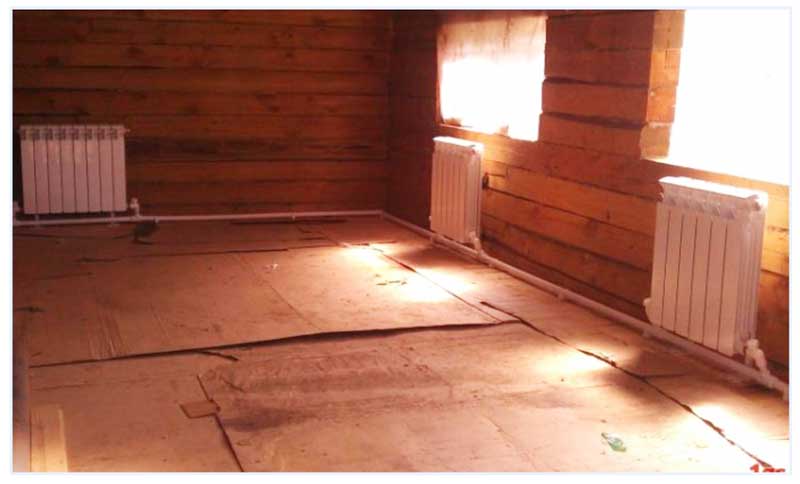

Fig. 5 "Leningradka" - a popular piping scheme for a one-pipe structure
Manually controlled bypass
Since a part of the coolant passes through the bypass, installed in parallel to the connected heat exchange devices, bypassing the heating devices, to increase the supply of the medium to the radiator, its cross section is made smaller than other pipes, increasing the hydraulic resistance. Typically, the diameter of the bypass in a one-pipe heating system is less than the pipes that fit from the central riser to the radiator by a quarter of an inch, which in turn have an outer dimension smaller than the riser pipes by the same amount.
It is clear that this system is unregulated and does not allow effective use of the system - the radiator with a large number of sections does not always fully warm up due to the escape of the coolant through the bypass pipe.
Passive bypass
In this case, switching occurs with a conventional mechanical toggle switch or button. This type was used on old models of lotions from various manufacturers.
This bypass is also called “cold” or “tru-bypass”.


Let's note the pluses of this type. When the bypass is turned on, the signal passes through the wires, bypassing electronic components, with virtually no distortion. In the absence of power, the signal easily passes through the lotion. The downside to passive bypass is that there are clicks when switching, as mechanical contacts are used. This is especially noticeable when working in a studio.
Bypass in the heating radiator piping
When installing the jumper assembly, the following basic rules are observed:
- The jumper is placed as close as possible to the inlet radiator fittings - this contributes to more efficient heating of the heat exchangers as a result of the passage of large volumes of the coolant through them.
- At the inlet and outlet of the batteries, it is necessary to place shut-off ball valves, which allow them to be disconnected from the network for preventive and repair work without draining the coolant and stopping heating.
- When using pipelines made of modern materials - metal-plastic or polypropylene for heating individual residential buildings, it is better to install a control valve in the bypass bypass. With its help, it is possible to reduce the flow passing through the jumper, and also to adjust the heating temperature of all radiators in the line by changing the cross-section of its passage channel.
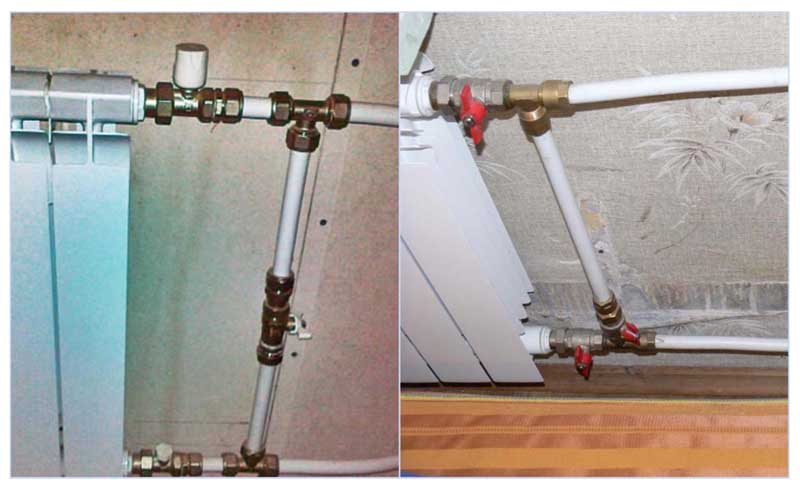

Fig. 8 Examples of installation of a control valve between bypass
What is a bypass on the radiator for?
As noted earlier, the use of a bypass with heating radiators is effective only in one-pipe circuits, the part allows you to achieve a more uniform heating of all heat exchange units. Also, the presence of a bypass allows water to be supplied to subsequent heat exchange devices in the event of failure or shutdown of one of them.
With the help of a jumper installed, the system can be manually adjusted so that all radiators are evenly heated. For this, the cross-section of the bypass bypass to the heat exchangers closest to the boiler is increased, and at the most distant radiators, it is reduced, thus controlling the flow passing through the batteries.
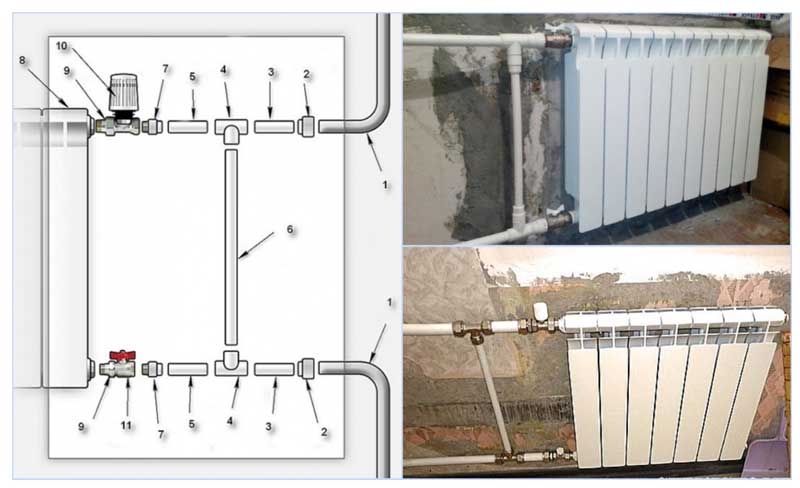

Fig. 9 Radiator piping with polypropylene and metal-plastic pipes
Self-assembly of the bypass in the radiator piping
Before installing the bypass, you can consider factory samples - the industry produces finished products for radiator heat exchangers, in which the distance between the connecting inlet fittings corresponds to the standard axial dimension from the upper and lower radiator connection points.
The problem of how to make a bypass to the heating system has different solutions depending on the material of the pipes used. Usually, self-installation of this element does not cause any particular difficulties for any owner (with the exception of polypropylene pipes) who has minimal plumbing skills and the necessary tools (one or two adjustable wrenches are needed).
Fig. 8 shows the installation of a bypass in a water supply line made of polypropylene, which is connected to a riser 1 through transition couplings 2. Bypass 6 is connected through a tee 4, connected to the mains by pipe sections 3 and 5. To thermostat 10, connected to a radiator 8 by means of an American 9 , a pipe segment made of polypropylene is connected using a fitting adapter from metal to polypropylene 7, in a similar way, the line is connected to the shut-off valve 11.
In this scheme, all pipes have the same outer size, therefore, the operation of such a structure is ineffective (the internal channel section of the bypass branch pipe in a single-pipe supply must be smaller); for its normal operation, it is necessary to insert a control valve into section 6, which reduces the channel passage opening.
In a similar way, a bypass jumper is mounted on the battery when using metal-plastic; the structure can be assembled most quickly using compression fittings (Fig. 8).
It should be noted that in the circuit in Fig. 8 pipe sections 5 are optional, the tee can be connected directly to the ball valve and thermostat by extending section 3.
If metal pipes are used in heating for water supply, a bypass jumper can be placed directly near the taps on the inlet and outlet battery fittings by connecting two tees to them. It is not difficult to make the diameter of the bypass lintel smaller than the main line with a small cross-sectional cross-section pipe; in this case, it is not necessary to put the shut-off valve in the lintel.
Installing a bypass - conditions and methods
Bypass for circulation pump with ball valve
Why do you need a bypass in the heating system in the area where the electric pump is installed? It would be more accurate to say that the pump is installed directly on it. This is practiced when an electric supercharger is placed in the gravity circuit, the one in which the circulation is carried out by gravity. It increases the flow rate and thus increases the efficiency of the circuit. This is due to the fact that at a higher speed the coolant reaches the extreme radiator with less heat loss.
There are two options for installing a bypass for a circulation pump:
- on a new circuit;
- on an existing contour.
There is no difference in installation. What you need to pay attention to is the presence of shut-off valves on the central line between the bypass pipes. This is necessary in order for the coolant to pass through the bypass for the circulation pump, and also so that a reverse flow is not created.
It is imperative to install a ball valve, and not a check valve, as some plumbers do.
To understand why, let's take a step-by-step look at how it works:
- when the pump is running, it accelerates the coolant;
- water from the bypass enters the main line and begins to move in both directions;
- in one direction (the right one), it leaves without hindrance, and in the second side it bumps into a check valve;
- the valve closes and thus prevents circulation in both directions.
That is, the water after the pump presses on the valve disc more strongly than before it, since the speed of the coolant behind the pump will be higher. As planned, when the pump is turned off, the coolant stops pressing on the check valve and does not block it. This allows water to circulate by gravity through the main line, without entering the bypass.In practice, the bypass for heating with a check valve does not work as expected.
The fact is that the check valve disc creates a strong hydraulic resistance equal to one meter. In the gravitational circuit, the coolant simply cannot withstand such valve resistance and the circulation will stop.
Therefore, before installing a bypass in a heating system with a check valve, you need to understand that, in fact, installing a pump on the bypass will not make any sense. With such success, it could be installed directly on the highway, while deliberately abandoning the possibility of using the heating circuit autonomously. Do you need a bypass in the heating system in this case? It turns out that, no.
If, instead of a check valve, you put an ordinary ball valve, then you yourself will be able to control the vector of water circulation along the contour. Let's take a look at how to make a bypass to the heating system, on which the pump will be installed. In such a scheme, it consists of separate elements:
- threaded nozzles that are welded into the line;
- ball valves - installed on both sides;
- corners;
- coarse filter - placed in front of the pump;
- two American women, thanks to which the pump can be removed for inspection or repair.
If you make a bypass in a heating system with your own hands, it is important to observe the correct location of the pump on it. The impeller shaft must be horizontal with the terminal box cover facing up. If, when correctly installed, the terminal box cover faces downward, it can be repositioned by unscrewing the four screws on the housing.
To install the bypass pipe in the heating system of polypropylene pipes correctly, follow these guidelines:
- The diameter of the bypass pipe is taken to be smaller than the diameter of the pipeline;
- The jumper should be located as far from the main riser as possible and as close to the serviced device as possible;
- The bypass is mounted horizontally to avoid air pockets;
- Install the bypass pipe section only after draining the coolant.
The first way to mount the radiator jumper is welded. The inclusion of polypropylene in the heating system ensures maximum reliability of the circuit, but steel pipes can also be used, albeit with less efficiency. PVC or metal pipes for the bypass are drilled in the right place, a lintel pipe is inserted into the hole, the joint is scalded.
The second method is clutch. The radiator is also dismantled, the jumper is fixed in place using factory couplings, shut-off valves are cut into the edges of the bypass. In the same way, the radiator is attached and connected to the circuit in a new place.
It is necessary to tell in more detail how to correctly install the bypass in the "warm floor" scheme, since the temperature of the coolant with such a solution should not be more than 45 ° C. The installation of a warm floor provides for the installation of a collector, and the bypass jumper on it acts as a bypass section of the heating route and a mixing unit.
The mixing unit in the manifold is a three-way valve with a temperature sensor. The valve divides the coolant flow into two parts, one of which it directs into the pipes of the "warm floor" device, and the second through a parallel line. In this case, the supply and return are mixed, after which the working fluid flows back to the boiler jacket.
Read more: Calculation of the heating system of a private house formulas and examples
Before making a bypass along a small circuit, you need to understand that a jumper through the three-way valve will connect the supply and return, that is, the collector must be included in the underfloor heating circuit. The bypass works in such a scheme as follows: after starting the boiler, the three-way closes the flow of cold working fluid from the heating main to the heat generator.
After the coolant heats up to the set temperature (45-50 ° C), the automatic valve will open and let a certain amount of hot coolant into the return pipe. This technique avoids the accumulation of condensate in the combustion chamber and on the surface of the boiler jacket.
A metal or PVC section of a bypass pipe is necessary in any heating scheme, since its use is an economical option for distributing heat with high efficiency while saving solid, gas, liquid or electrical energy. Simply put, the volume of the coolant that is supplied to radiators and other devices and devices is reduced when the bypass is installed, without violating the norms for calculating heat transfer from both individual elements of the system and the entire structure.
As a rule, it is necessary to embed a circulation pump into the heating system together with the bypass section of the pipe. The installation of bypasses can be done by hand. The circulation pump must be installed in just such an area. In this case, the bypass will consist of the following interconnected parts: a filter, a pumping device, a shut-off valve, which can be replaced by an automatic valve.
In this case, the entire system must be installed in the pipeline near the area connected to the boiler. This requires the installation of a shut-off valve in the section from the entrance to the exit of the bypass path.
Consider the principles of operation of a heating system with a circulation pump and a bypass.When the circulation pump is turned on, the valve located on the bypass pipe must be opened, since during this period the liquid moves just along the bypass path. This requires the closure of the ball valve, which is located on the main pipeline.
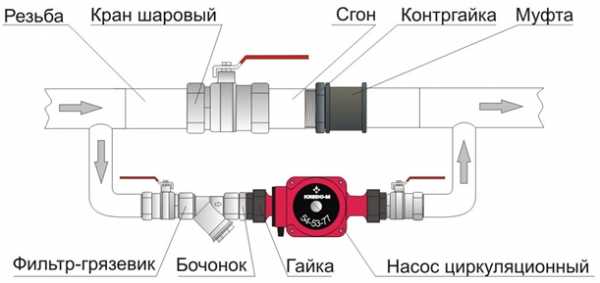

Similar actions are performed in the event of a power outage, since in this case the operation of the circulation pump stops. The shut-off valves will allow the water to be directed towards the return. It should be noted that the bypass system may have a check valve, in this case it is enough to do with opening the tap on the return line.
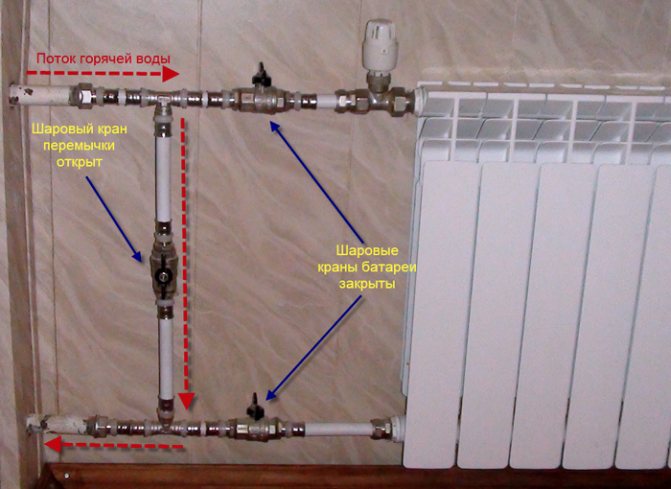

The nuances of installing a regulating device are shown in the diagram
In a one-pipe design, the installation of a bypass for heating is necessary so that when the heating device is replaced, the liquid continues to circulate. In a vertical installation, the radiator is connected to the riser with pipes. The regulator combines the pipes and is mounted in front of the battery.
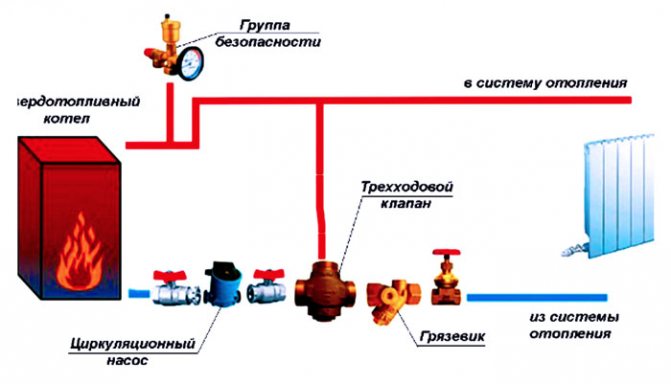

The diagram shows the installation location of the bypass jumper on the entire heating system when using a solid fuel boiler
- creation of constant movement along the main contour;
- regulation of temperature and flow rate of the coolant directly in the radiator.
Installation of a bypass allows mixing the coolant from the central line with the return line of the battery. This increases the temperature and heating efficiency in general.
The nuances of strapping
- in order to direct the water in the right direction, it is necessary that the cross-section of the lintel is smaller than the cross-section of the main pipeline;
- installation of the structure is carried out next to the heating device, but as far as possible from the riser;
- taps are mounted between the battery inlet / outlet and the regulating jumper;
- thermostats are used to automate the temperature of the device;
- when installing the structure next to the boiler, overheating must not be allowed;
- tees are mounted on the sections of the line;
- do not install a valve or valve on a valveless device.
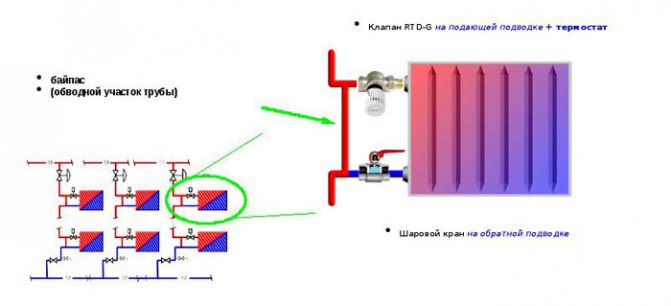

One-pipe piping option
When installing the unit, the building codes must be observed. There must be fasteners or special pipe supports near the bypass device.
Bypass in the circulation pump unit
In modern heating, circulating electric pumps are gradually replacing wiring with natural circulation due to their advantages: the rapid movement of the fluid flow and the regulation of the speed of its movement, which allows for accelerated heating of a cold room. An important advantage is the ability to program the operating modes, the safety of a closed loop when using poisonous antifreeze antifreeze - ethylene glycol.
The only drawback is the dependence on the circulation pump - if there is no power supply or a breakdown occurs, the heat supply becomes impossible. The use of a simple jumper between the sections of the forward and reverse branches with an installed electric pump allows you to get rid of this problem, creating a bypass path for the working fluid. When connecting, it is better to install the element horizontally, although in practice you can also find a vertical arrangement of the bypass.
Sometimes a shut-off valve is cut into the bypass branch pipe, while the other two taps are mounted at the inlet and outlet of the unit with a circular pump - this makes it easy to dismantle the pumping equipment without draining water for repair, maintenance, replacement.
Where else is the bypass used in heating
The answer to the question, what is the bypass in the heating system for, cannot be complete without considering other options for its placement. Many people encounter a similar device every day, using a heated towel rail connected parallel to the central riser. We will consider other areas of use of the bypass pipe below.
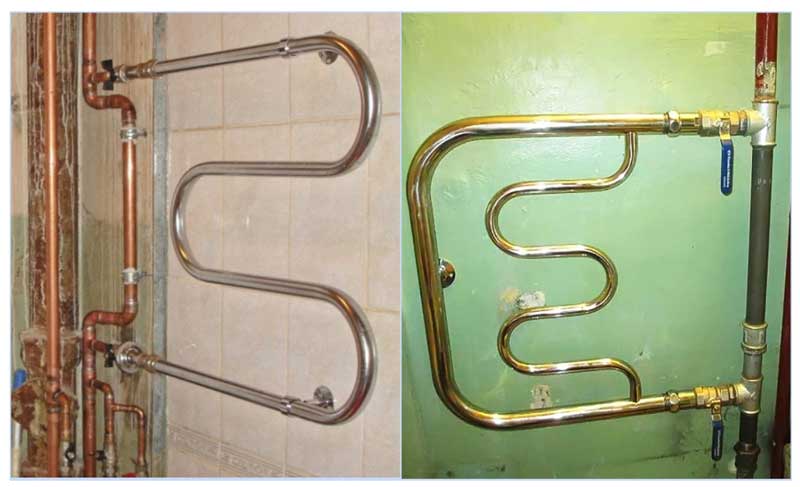

Fig. 11 Heated towel rail - connection options
Bypass in the underfloor heating circuit
In the presence of a large number of warm water floors in a private house, their connection is carried out according to a collector circuit - this ensures the same pressure and water temperature in each circuit.
Unlike an in-house heating system, the heating of the heat carrier of a warm floor should not exceed 45 degrees - this is due to the convenience of using the floors (too hot a floor covering is impractical and harmful to health) and the extreme temperature characteristics of heat transfer pipes.
The fact is that polyethylene of increased temperature resistance PE-RT, which is an excellent option when used as a pipeline for a warm floor, has a maximum temperature threshold of + 70 C., therefore, liquid with higher temperature values should not be supplied to it.
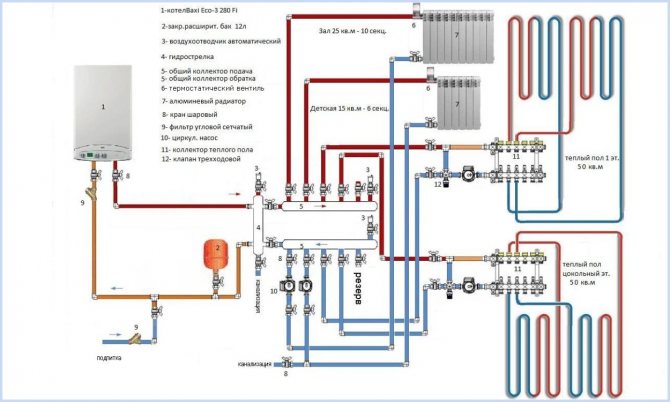

Fig. 12 Multi-circuit collector circuit for heating a cottage
The bypass connecting the supply line located at the bottom of the collector group (determined by the presence of flow meters) and the upper return line (on its collector there are control valves with removable caps for screwing the servos) feeds cooled water from the return line to the direct collector inlet. Thus, through the mixing unit in the form of a tee, a decrease in the total temperature of the incoming liquid is achieved by mixing in a cold water flow to it.
There are ready-made manifold mixing units on sale, in which a circulating electric pump, balancing valves for each branch, water meters, thermostat, air outlets are installed, some models are equipped with pressure control devices. Many modifications do not have a built-in bypass, which is usually not installed in two-pipe systems and is considered an unnecessary part in them. But some models have this element, another role of which is to compensate for excess pressure in the underfloor heating pipeline, when it rises, part of the flow enters the return line if its collector is located below the direct one. At the same time, the element reduces the consequences of hydraulic shocks that occur when the circular electric pump is turned on and off in the underfloor heating line.
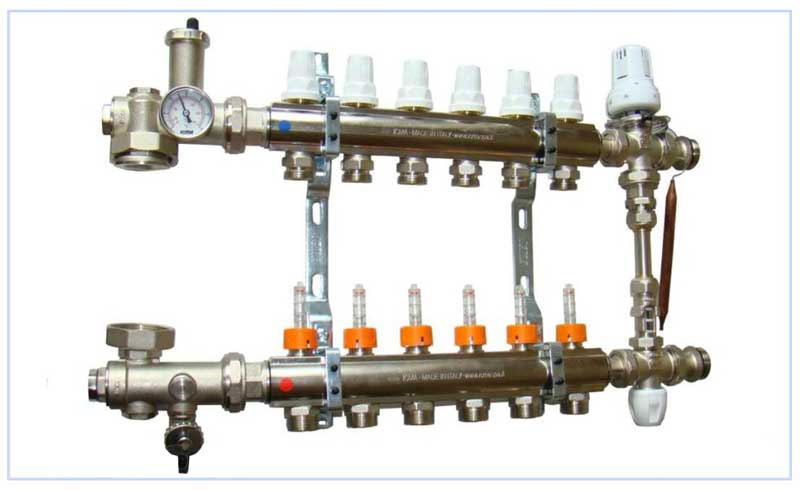

Fig. 13 Manifold with jumper tube
Bypass diameter
Pipe sizing diagram in a system with a bypass on the radiator
So, we already know why a bypass is needed in the heating system and where it is installed. It remains to figure out what diameter it should be. We must consider the options for installing the heating system bypass on the battery and pump separately, since its diameter in each case will be different, which is due to different requirements for it.
The bypass on the pump will be smaller or the same diameter as the main line. How to make a bypass for heating correctly, there is no fundamental difference in this case. After all, it is installed only so that in the event of a pump shutdown, circulation can continue by gravity.
Accordingly, it is impossible to narrow the line itself, while the diameter of the nozzles that depart from the contour is not of key importance. When the pump is stopped, circulation through it will be impossible, therefore, even with an equal diameter with the common line, the bypass will not change the vector of movement of the coolant.
But when installing a bypass in the heating system of a private house on radiators, its diameter is of great importance. It should be one size smaller than the pipes connecting the radiators to the central line. In this case, the outlets to the batteries should also be one size smaller than the main circuit. How it works:
- water flows along the contour and reaches the area where the batteries are installed;
- bumping into a fork, the coolant changes the vector of motion in the direction where there is less resistance;
- part of the coolant continues to move in the same vector.
If the diameter of the nozzles is the same as the bypass, then a small amount of water will get into the batteries, respectively, the temperature of the radiators will drop. If the diameter of the nozzles is less than the diameter of the bypass, then the circulation in the battery will stop altogether.
Reducing the diameter of the pipes in relation to the main line increases the speed of the coolant, which allows it to move more intensively along the radiator. In this case, the water circulates throughout the battery, as a result of which it warms up evenly.
Read next: How to install a washbasin with a pedestal
For example, consider a bypass device in a polypropylene heating system. If the diameter of the main line is 32 mm, then the cross-section of the pipes through which water enters the batteries should be 25 mm. The diameter of the bypass in this scheme, respectively, should be 20 mm. In this case, to the extreme battery, the coolant will pass along the path we need with minimal heat loss. This will make it easier to balance the system.
Bypass in the piping system of a solid fuel heating boiler
The main difference between a solid fuel boiler and a gas boiler is the high combustion temperature of heating materials (charcoal and coal, firewood, peat briquettes, pellets) and the impossibility of adjusting it.
If you heat up solid fuel heating boilers, they reach very high temperatures within a short time, and the interaction of hot air with a cold heat carrier leads to too large a temperature difference. This factor negatively affects the strength characteristics of the materials separating the sources, leading to their accelerated wear - cast iron does not like such temperature fluctuations and can crack, and steel is subject to increased corrosion. In addition, rapid high-temperature heating contributes to the formation of condensate on the surface of the chimney, on which the soot entering with the smoke settles.
The only technically acceptable and competent way out of the situation is to reduce the time period for the interaction of hot air in the boiler with a cold coolant. To solve this problem, a small heating circuit of a solid fuel boiler is created in which a small amount of liquid circulates. Moving in a closed circle through the bypass jumper, the water quickly warms up, after which it gradually enters the main system through a slightly opening thermostatic valve set at a certain temperature. Hot water mixes with the main heat carrier and gradually heats it up, ensuring a smooth start of the entire system without sudden temperature changes. This technique significantly extends the service life of all equipment, reduces the frequency of preventive maintenance to clean the chimney ducts, and increases the efficiency of the system.
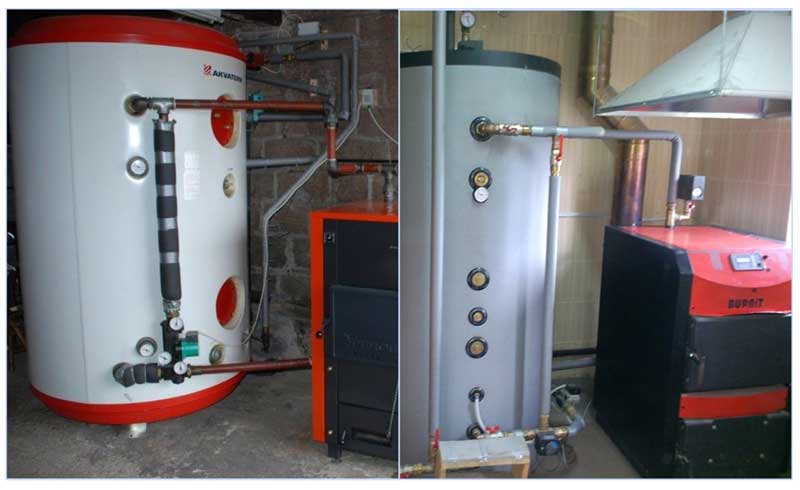

Fig. 14 Bypass in the piping system of a solid fuel boiler
Specialist answers to questions
Most often, people who are not well versed in individual heating, the question arises - is a bypass needed in a two-pipe heating system next to radiators? If we consider a one-pipe heating system, a jumper is usually installed in it to ensure the operability of the entire line when one of the heat exchange elements in the circuit is disconnected or malfunctioning, their uniform heating, and the need for a bypass is beyond doubt. In a two-pipe wiring, such problems do not arise by definition, each circuit is connected independently of the others, and a coolant of the same temperature is supplied to everything.
The simplest jumper from the pipe section in the heating line performs many functions in a single-pipe wiring diagram - it maintains constant temperatures on all heat exchangers and the uninterrupted operation of the entire system, ensures high maintainability of the heating elements. Also, a bypass branch pipe can be found in underfloor heating systems and piping of solid fuel heating boilers, where it increases the efficiency and reliability of the equipment.
How is the warm floor used in the system?
In a residential building, underfloor heating is connected to a boiler, from which hot water supply and heating are supplied.In this case, the water temperature for all structures will be the same. So that the water in the underfloor heating structure is not so hot, special mixing units are used. To prevent a strong pressure surge, a bypass with a valve is installed in the unit.
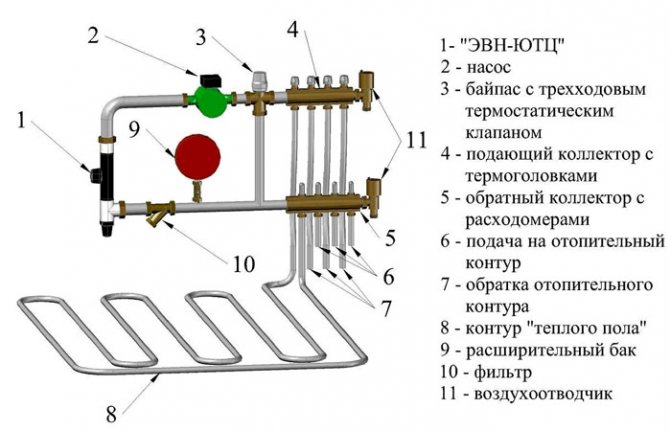

Scheme of the structure of a warm floor

